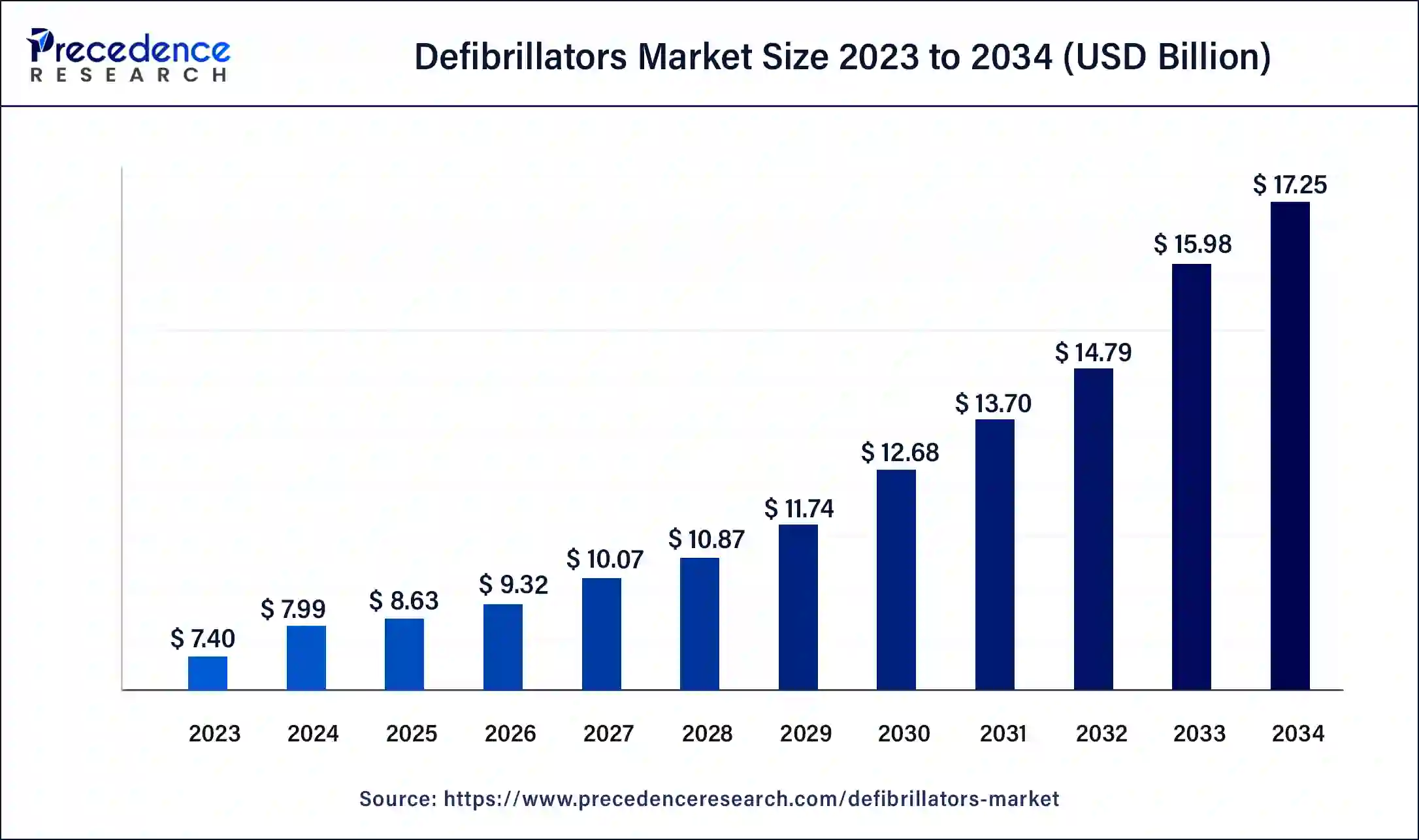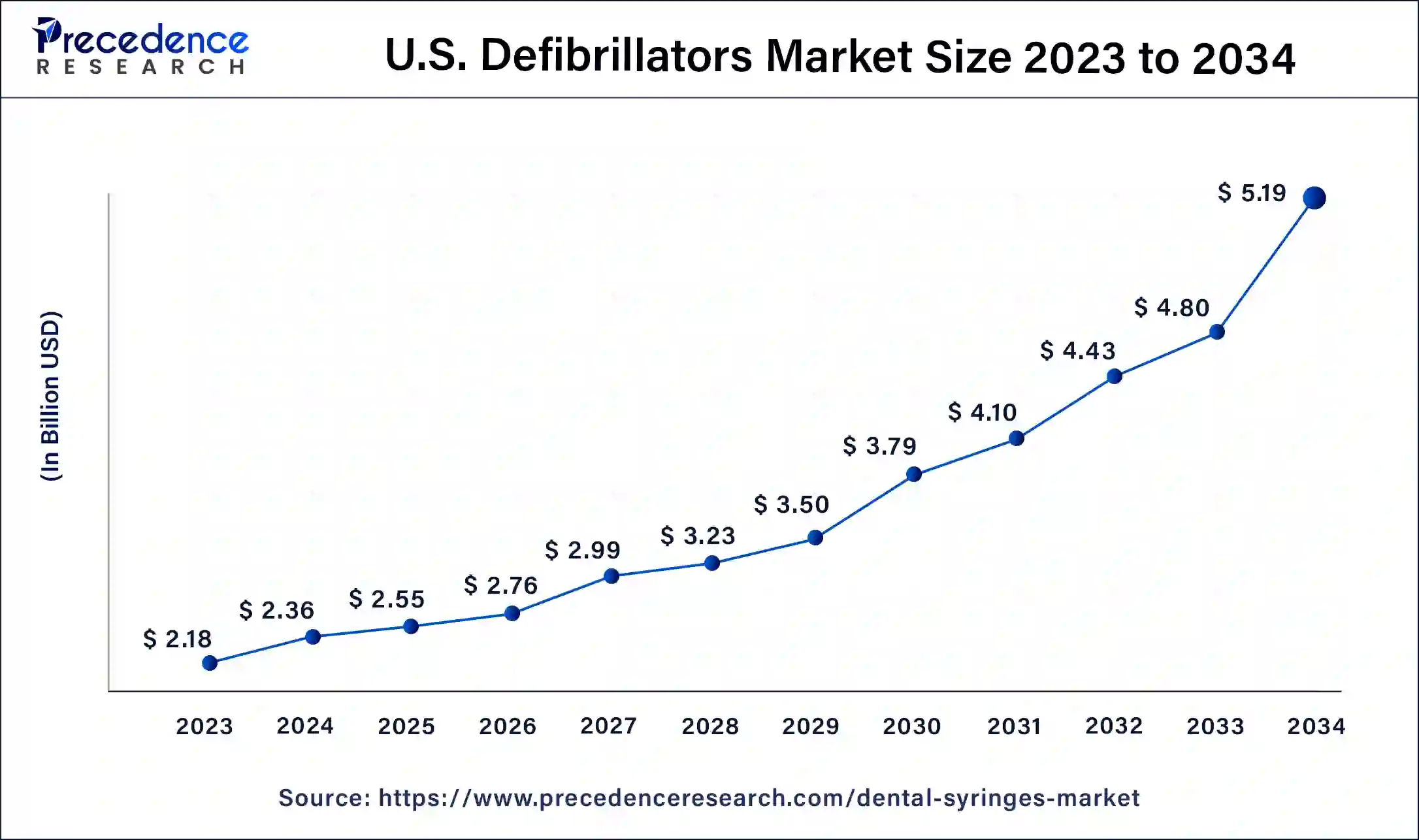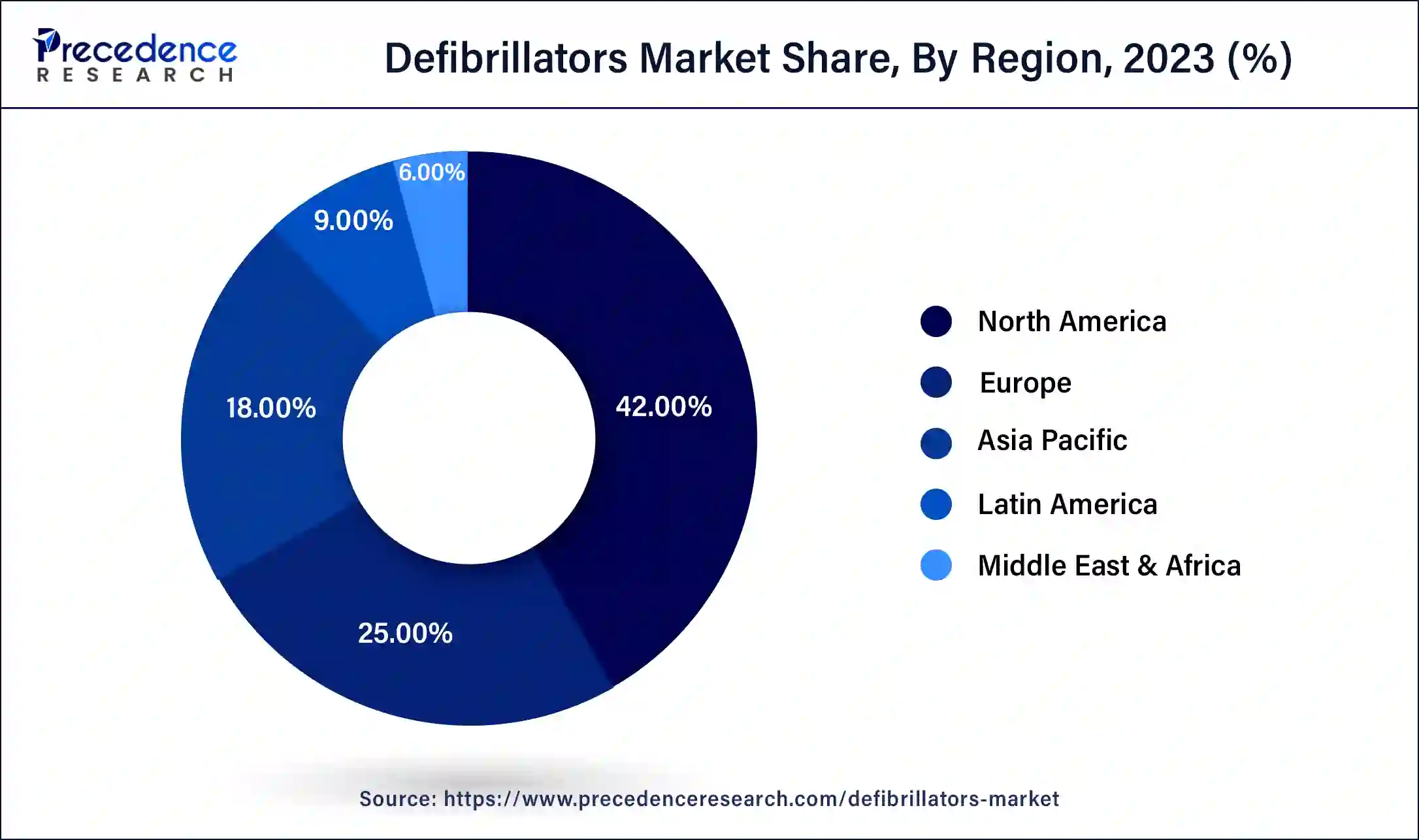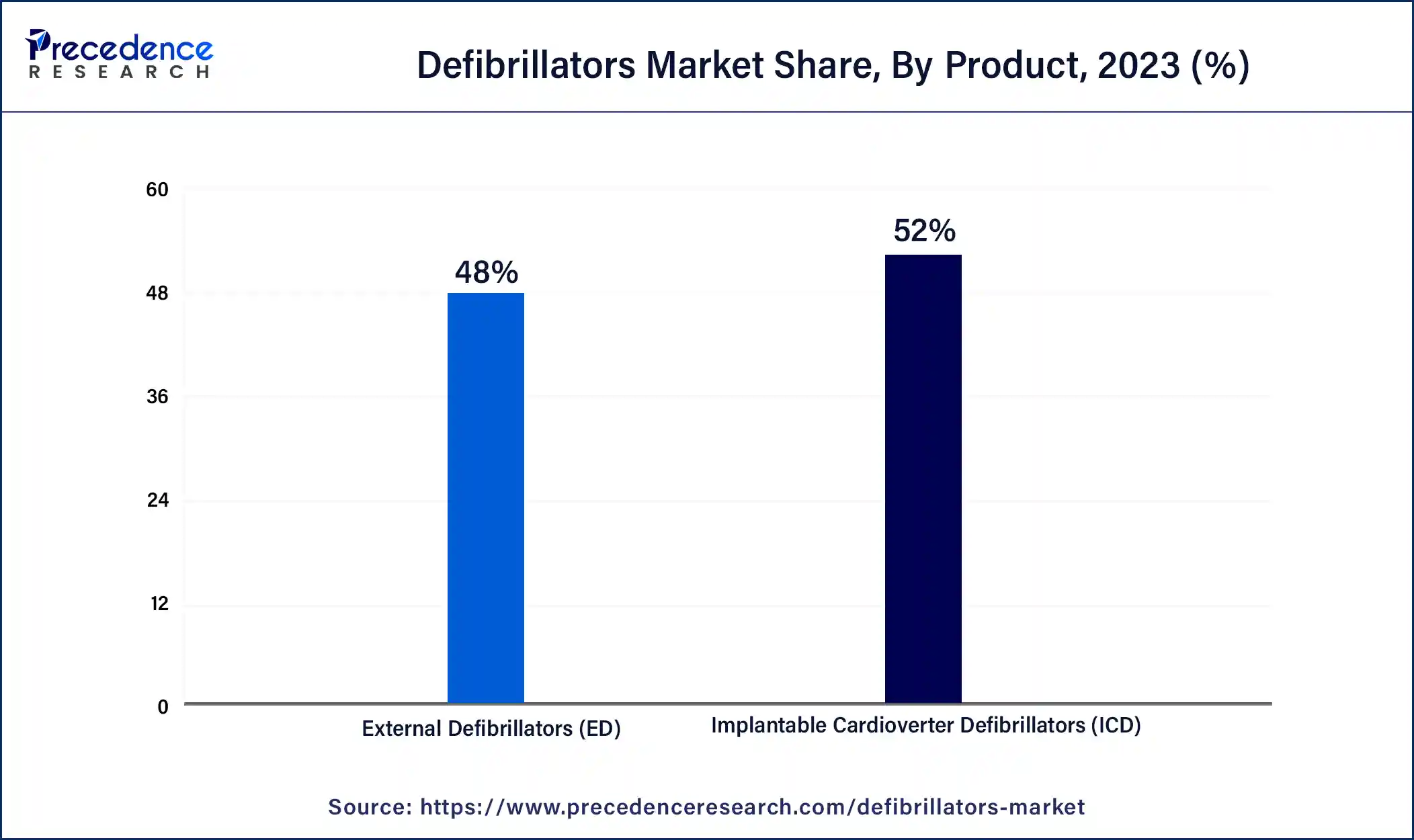March 2024
Defibrillators Market (By Product: Implantable Cardioverter Defibrillators (ICD), External Defibrillators (ED); By End use: Hospital, Pre-hospital, Public Access Market, Alternate Care Market, Home Healthcare, By Patient Type: Adult, Pediatrics) - Global Industry Analysis, Size, Share, Growth, Trends, Regional Outlook, and Forecast 2024-2034
The global defibrillators market size accounted for USD 7.99 billion in 2024 and is expected to reach around USD 17.25 billion by 2034, expanding at a CAGR of 8% from 2024 to 2034. The North America defibrillators market size reached USD 3.11 billion in 2023. Due to the increased incidence of cardiovascular diseases among the aging population, there is a greater need for defibrillators as these individuals are more prone to cardiac events.

The U.S. defibrillators market size was estimated at USD 2.18 billion in 2023 and is predicted to be worth around USD 5.19 billion by 2034, at a CAGR of 8.2% from 2024 to 2034.

North America holds the largest share of the defibrillators market. Significant technological advances in defibrillator devices have been made available to the market, such as the creation of automated external defibrillators (AEDs) with improved features, including integrated CPR feedback, real-time monitoring, and Wi-Fi connectivity for data transfer. Regulatory agencies like the food and drug administration (FDA) in the US have strict policies and rules in place to guarantee the security and effectiveness of defibrillator devices.
For the participants of the defibrillators market to sell their goods in the area, adherence to these rules is necessary. Organizations operating in the market consistently allocate resources toward research and development in order to launch novel items that exhibit enhanced functionality, dependability, and user-friendliness. Innovation is concentrated in a few areas, including software algorithms, electrode design, and battery technological advancements.

Asia Pacific is also expected to witness the fastest growth during the forecast period in the global defibrillators market. Due to the rising incidence of cardiovascular illnesses and the increased use of defibrillator devices in a variety of healthcare settings, the market has been developing. The governments of a number of Asia Pacific nations have been making investments in the construction of healthcare infrastructure and putting plans into place to increase access to healthcare services, especially emergency medical attention.
Significant technological improvements in the defibrillators market have been made, including the creation of portable and automated external defibrillators (AEDs), which are being used more frequently in public locations, including sports arenas, airports, train stations, and retail centers.
Globally, cardiovascular diseases (CVDs) continue to be one of the main causes of death. One important symptom of CVDs is sudden cardiac arrest (SCA), which raises the need for defibrillators. Technological developments such as wearable defibrillators, implanted cardioverter defibrillators (ICDs), and automated external defibrillators (AEDs) have significantly advanced the defibrillators market.
Defibrillator devices are now more effective, portable, and user-friendly because of these advancements. Increased emphasis has been placed on defibrillator use and cardiopulmonary resuscitation (CPR) through awareness campaigns and training programs. Defibrillators are now more widely available to the public thanks to their installation in public areas, companies, and schools.
The defibrillators market has been stimulated by government initiatives to improve cardiac emergency response systems and by rules requiring the placement of defibrillators in public areas. For instance, several nations have put laws into place mandating that AEDs be available at specific public locations. Increasing healthcare spending, especially in industrialized nations, has made modern medical devices like defibrillators more widely used.
The defibrillators market is marked by fierce competition between major competitors, which encourages ongoing product innovation and tactical alliances. In addition, there has been some market consolidation as a result of acquisitions and mergers by industry leaders. Defibrillator makers should expect substantial development prospects as a result of the increased urbanization, changing lifestyles, and improved healthcare infrastructure observed in emerging economies.
| Report Coverage | Details |
| Growth Rate from 2024 to 2034 | CAGR of 8% |
| Global Market Size in 2023 | USD 7.40 Billion |
| Global Market Size in 2024 | USD 7.99 Billion |
| Global Market Size by 2034 | USD 17.25 Billion |
| Largest Market | North America |
| Base Year | 2023 |
| Forecast Period | 2024 to 2034 |
| Segments Covered | By Product, By End-use, and By Patient Type |
| Regions Covered | North America, Europe, Asia-Pacific, Latin America, and Middle East & Africa |
Rising awareness about sudden cardiac arrests
Rising awareness about sudden cardiac arrests is a significant driver for the defibrillators market. PAD programs are increasingly being implemented by governments, healthcare institutions, and communities globally. The goal of these programs is to increase the accessibility of defibrillators in public areas, including schools, workplaces, sports complexes, and airports. Defibrillators are widely placed in various areas, making them more accessible during crises and possibly saving more lives. Automatic external defibrillators, or AEDs, are made to be simple to operate, even for non-medical personnel.
The addition of intelligent elements like real-time feedback and connectivity to emergency services improves defibrillator efficacy in saving lives. Understanding initiatives by advocacy groups and healthcare organizations, combined with media coverage of high-profile events involving sudden cardiac arrest, have helped raise public understanding of the use of defibrillators. Thus benefiting the defibrillators market.
Maintenance and replacement costs
High maintenance and replacement expenditure can inhibit the growth of the defibrillators market. The kind and features of the device determine the defibrillator's initial purchasing price. Compared to advanced cardiac life support (ACLS) defibrillators used in hospitals and other medical facilities, automated external defibrillators (AEDs), which are frequently utilized in public places, are typically less expensive. Effective defibrillator operation requires training for medical staff.
Moreover, upgrades in the defibrillators market require the operators to undergo frequent training. Training expenditures include initial staff training and continuing education to maintain competency. Healthcare facilities also consider the total cost of ownership (TCO), which includes defibrillator replacement and maintenance during the device's lifetime, in addition to the initial purchase price.
Telemedicine and remote patient monitoring
Within the defibrillator market, the telemedicine and remote patient monitoring segment has been expanding quickly. This expansion has been driven by factors including the aging population, increased prevalence of cardiovascular disorders, and improvements in telecommunication technologies. By integrating with telemedicine systems, medical practitioners can evaluate patients' heart problems from a distance, offer consultations, and modify treatment programs as needed.
Regulators such as the European Medicines Agency (EMA) in Europe and the Food and Drug Administration (FDA) in the United States have created guidelines for the development and approval of telemedicine and remote monitoring systems in medical devices, including defibrillators.
The ICDs segment holds the largest share of 52% in 2023. Sophisticated medical devices called implantable cardioverter defibrillators, or ICDs, are made to monitor cardiac rhythm and provide treatment when potentially fatal arrhythmias are identified. They are frequently administered to individuals who have ventricular fibrillation or tachycardia, which puts them in danger of abrupt cardiac arrest. ICD technology is constantly evolving, resulting in devices with longer battery lives, more compact designs, better sensor capacities, and sophisticated algorithms for arrhythmia identification and treatment administration.
The demand for ICDs is driven by the rising prevalence of cardiovascular disorders, including those that put a person at risk for sudden cardiac arrest. The market for ICDs is boosted by factors including aging populations, sedentary lifestyles, and bad dietary habits, which all contribute to the increased occurrence of cardiac problems.

Heart conditions, including heart failure and coronary artery disease, are becoming more common as the world's population ages. Defibrillators are becoming more and more popular since an aging population is more likely to have arrhythmias that require ICD installation. The demand for ICDs is driven by raising knowledge of the value of early diagnosis and management of cardiac arrhythmias through educational campaigns and initiatives by governmental and healthcare organizations.
The defibrillator industry is fiercely competitive, with a number of well-known companies vying for market dominance through innovative product development, business alliances, and international expansion. Businesses spend money on R&D to release ICDs with cutting-edge technology, which increases competition and propels market expansion.
The hospital segment held the dominant share of the defibrillator market and is expected to maintain this dominance during the forecast period. One of the main places defibrillators are utilized is in hospitals. They are commonly located in critical care settings such as operating rooms, intensive care units, and emergency departments. Hospitals purchase high-quality defibrillators because they can save lives, and this ensures that they have the tools they need to react fast to cardiac emergencies.
The defibrillators market is made up of a variety of devices, including external defibrillators used in ambulances and hospitals, implanted cardioverter-defibrillators (ICDs), and automated external defibrillators (AEDs). They frequently compete on the basis of features including new product development, dependability, user-friendliness, and post-purchase assistance and service.
The public access market segment is expected the fastest growth during the forecast period. The term "public access market" for defibrillators describes the accessibility and availability of these devices in public areas, including shopping centers, schools, sports arenas, airports, and other community sites. Defibrillators are vital medical equipment that shock the heart with electricity in the event of sudden cardiac arrest (SCA), which can happen outside of hospitals and frequently in public areas.
Defibrillators are positioned in high-traffic locations or areas where a lot of people congregate in order to increase the likelihood that one will be available when needed. Efforts are made to tell people about defibrillators' availability in their local areas and to increase public awareness of their significance.
Segment Covered in the Report
By Product
By End-use
By Patient Type
By Geography
For inquiries regarding discounts, bulk purchases, or customization requests, please contact us at sales@precedenceresearch.com
No cookie-cutter, only authentic analysis – take the 1st step to become a Precedence Research client
March 2024